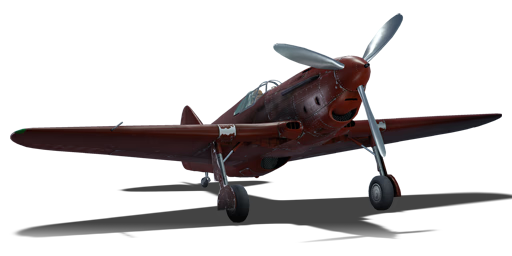


The I-301 was the prototype for the LaGG-3 fighter series, so construction, flight characteristics and performance are similar to them. Unlike many fighters, the I-301 was made of wood and polymer, which contributed to its flying capabilities. A successful prototype made its maiden flight in March 1940. The aircraft was powered by a 12-cylinder liquid-cooled Klimov M-105P inline engine with a rated output of 1,050 hp and its armament, at the beginning, was insanely powerful for its time, with a 23 mm PTB-23 cannon with 81 rounds of ammunition. The aircraft suffered from poor operational range, so two extra fuel tanks were added in the wings.
The I-301 was introduced during Update 1.43 as part of a giveaway in the 2014 Winter Holiday event. Besides being only marginally faster than the rank II LaGG-3-66 in level flight and in a climb, the I-301 shares many characteristics with the LaGG-3-8, with the exception of the massive increase in firepower. The I-301’s firepower is a step above other LaGG-3 fighters due to the extra machine guns and powerful cannon. The cannon is a 23 mm PTB-23 cannon, which in-game is similar to the 23 mm on the IL-2 attackers. As for machine gun armaments, the I-301 has two 12.7 mm HMGs as well as two 7.62 mm machine guns. With four machine guns and a cannon mounted in the V of the engine, the I-301 is a well-armed fighter for its BR. With its flight characteristics, it is a fighter well-suited for boom and zoom tactics. However, it catches fire easily like the LaGG-3 due to the wing-based fuel tanks, and the engine is prone to overheating rather quickly.
flaps
flaps
flaps
brake
| Belt | Belt filling | Armor penetration (mm) at a distance: | |||||
|---|---|---|---|---|---|---|---|
| 10 m | 100 m | 500 m | 1000 m | 1500 m | 2000 m | ||
| FI-T/AP-I | 46 | 42 | 29 | 19 | 12 | 8 | |
| FI/FI-T/AP-I | 46 | 42 | 29 | 19 | 12 | 8 | |
| AP-I/AP-I/AP-I/FI-T | 46 | 42 | 29 | 19 | 12 | 8 | |
| Belt | Belt filling | Armor penetration (mm) at a distance: | |||||
|---|---|---|---|---|---|---|---|
| 10 m | 100 m | 500 m | 1000 m | 1500 m | 2000 m | ||
| T/AP/AP/IAI | 32 | 30 | 22 | 15 | 11 | 7 | |
| AP-I/API-T/IAI/IAI | 29 | 27 | 20 | 13 | 9 | 6 | |
| API-T/AP-I/AP-I/IAI | 29 | 27 | 20 | 13 | 9 | 6 | |
| AP-I(c)/AP-I/AP-I/API-T/IAI | 34 | 32 | 24 | 17 | 12 | 8 | |
| API-T | 29 | 27 | 20 | 13 | 9 | 6 | |
| AP-I/AP-I/IAI | 29 | 27 | 20 | 14 | 9 | 6 | |
| Belt | Belt filling | Armor penetration (mm) at a distance: | |||||
|---|---|---|---|---|---|---|---|
| 10 m | 100 m | 500 m | 1000 m | 1500 m | 2000 m | ||
| T/Ball/Ball/AP-I/AI | 13 | 12 | 7 | 3 | 2 | 0 | |
| AP-I/AI/API-T | 13 | 12 | 7 | 3 | 2 | 0 | |
| AP-I/API-T | 13 | 12 | 7 | 3 | 2 | 0 | |
| AP-I/AP-I/AP-I/AI | 13 | 12 | 7 | 3 | 2 | 0 | |







 2 x (35 / 60 / 140) %
2 x (35 / 60 / 140) % 
 2 x 112 %
2 x 112 % 

Flight performance | |
|---|---|
Survivability |
|---|
Weaponry | |
|---|---|